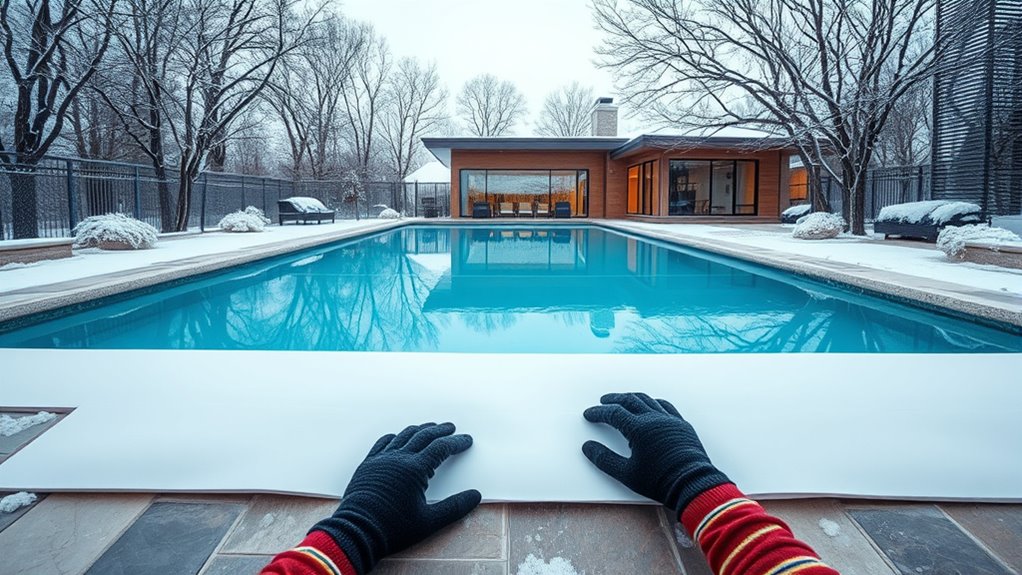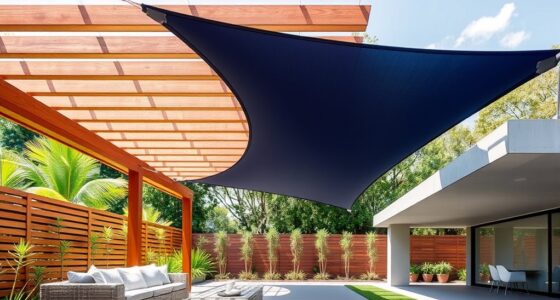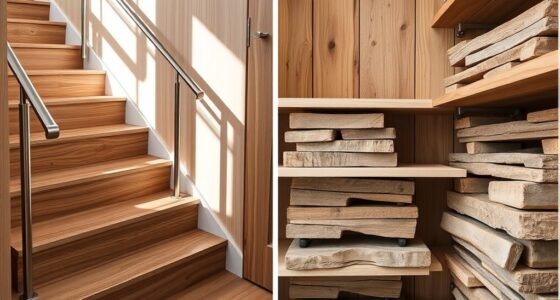To winterize your infinity pool in cold climates, start by thoroughly cleaning and lowering the water level 4-6 inches below the skimmer. Balance the water chemistry, then drain all equipment, pipes, and channels to prevent freezing damage. Add appropriate winterizing chemicals and pool-specific antifreeze to protect plumbing. Secure and insulate equipment, cover the pool, and ensure all components are protected from harsh weather. Continue with some simple steps to safeguard your pool for winter’s chill, and discover more tips to keep it safe and sound.
Key Takeaways
- Drain water below skimmer and equipment openings, typically 4-6 inches below the skimmer, to prevent freezing damage.
- Add pool-specific antifreeze to plumbing lines, skimmers, and pumps to protect against ice expansion.
- Remove and store pumps, filters, and heaters in a dry, protected area; insulate exposed plumbing with foam sleeves.
- Cover the pool with a sturdy, secure winter cover and insulate equipment to prevent debris entry and cold damage.
- Regularly inspect for ice buildup, cracks, or leaks during winter and perform necessary maintenance before spring reopening.
Assessing Your Pool’s Winter Readiness
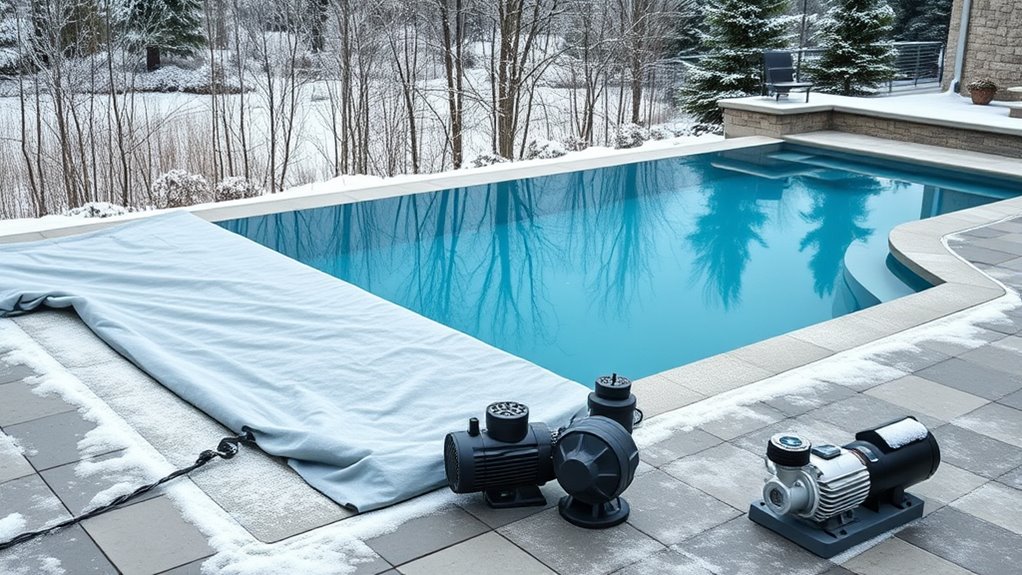
Have you checked whether your infinity pool is ready for winter? First, inspect the water level; it should be slightly below the skimmer opening to prevent ice damage. Check the pool’s equipment, including filters, pumps, and heaters, ensuring they’re in good working order and free of debris. Examine the structural features, like the coping and tiles, for any cracks or damage that could worsen in freezing temperatures. Test the water chemistry—pH, alkalinity, and calcium hardness—to prevent corrosion and algae growth during winter. Ensure your safety features, such as handrails and ladders, are secure. Finally, review your pool’s overall condition, making notes of any repairs needed before cold weather hits. Proper assessment now saves you time and money later. Additionally, tuning your pool’s filtration system can optimize performance and longevity during colder months.
Cleaning and Draining the Pool Properly
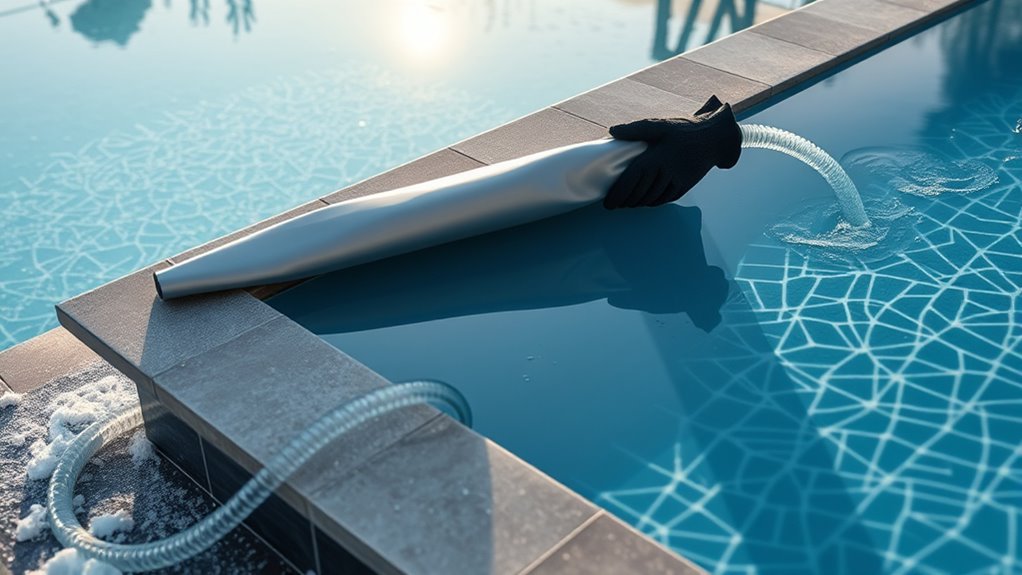
After confirming your pool’s readiness, it’s time to focus on cleaning and draining it properly. First, remove all debris using a skimmer net and brush the surfaces to prevent algae buildup. Next, vacuum the pool thoroughly to clear dirt and sediment. Then, drain the water completely using your pool’s pump or drain plug, ensuring no water remains in pipes or equipment. Finally, follow these essential steps:
- Clear skimmer and pump baskets to prevent ice damage.
- Blow out remaining water in plumbing lines to avoid freezing.
- Disconnect and store all pool equipment safely indoors.
- Cover the pool with a sturdy winter cover, securing it tightly.
- Consider adding AI-powered monitoring devices to track pool conditions during the off-season and alert you to potential issues.
Performing these steps carefully protects your pool from winter damage and makes spring startup easier.
Balancing Water Chemistry for Protection
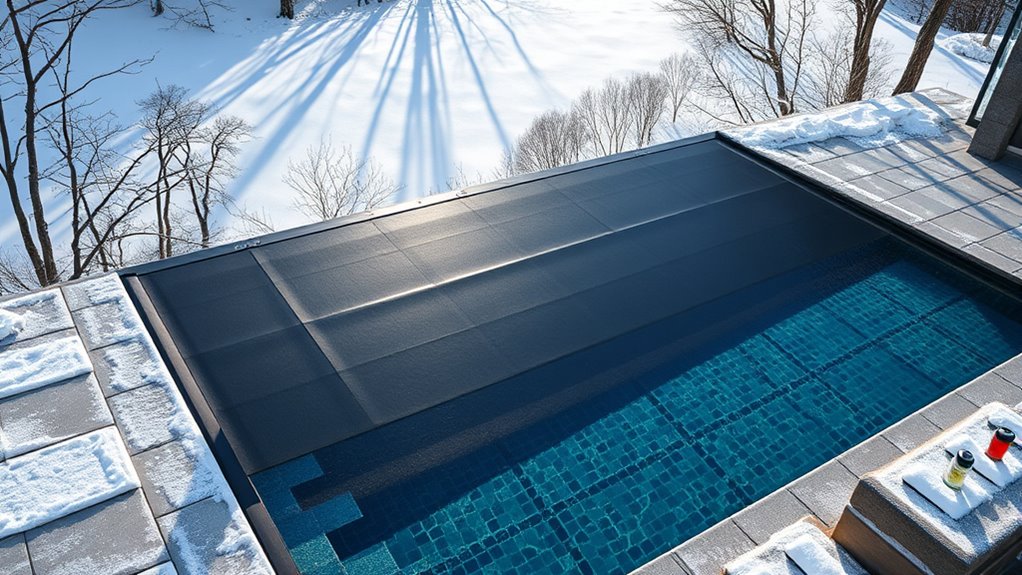
Balancing your pool’s water chemistry is essential to prevent corrosion and scale formation during the winter months. You want the pH level between 7.2 and 7.6 to minimize corrosion of pool components and protect the finish. Adjust alkalinity to around 80-120 ppm to stabilize pH and prevent fluctuations. Ensure calcium hardness stays between 150-250 ppm; too high can cause scale, while too low risks corrosion. Use a pool test kit to regularly check these levels and make adjustments with proper chemicals. Maintaining proper water chemistry helps prevent damage to your pool’s surfaces and equipment during the cold season. Proper filtration methods are also important to improve overall water quality and reduce contaminants. Consistent monitoring and adjustments now will save you time and expense when you reopen the pool in spring.
Lowering Water Levels Safely
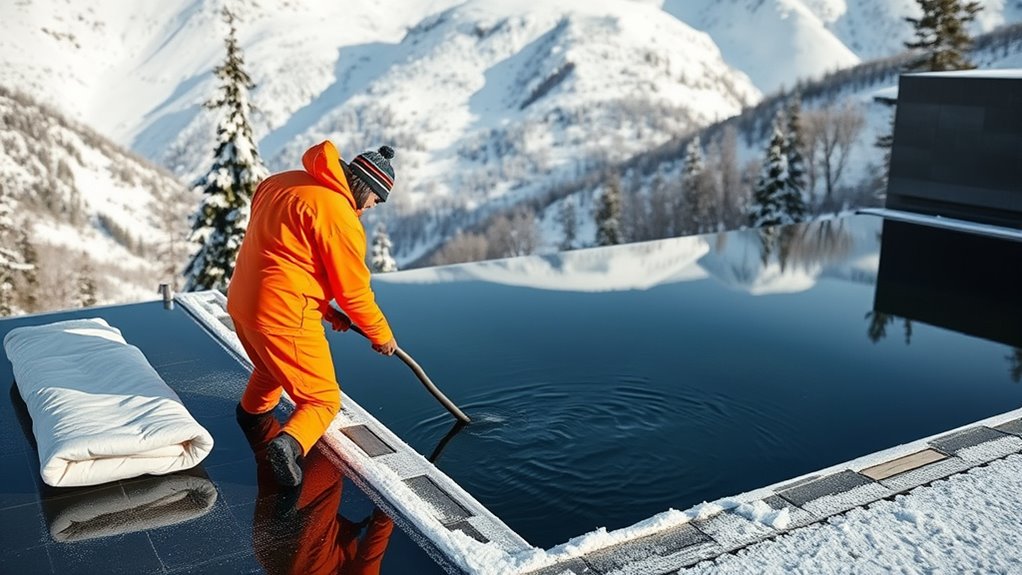
To lower the water level safely, start by draining excess water carefully to prevent damage. Make sure you use the proper equipment, like a submersible pump or siphon, to control the process. Keep a close eye on the water levels throughout to avoid over-draining or leaving too much behind. Additionally, understanding outdoor kitchen design principles can help in planning appropriate maintenance procedures for your pool area during winter.
Drain Excess Water
Lowering the water level safely is a crucial step in winterizing your infinity pool, especially in cold climates where freezing can cause serious damage. To do this effectively:
- Remove water from the main basin until it’s about 4-6 inches below the skimmer opening.
- Drain the overflow trough and ensure no water remains in the channels that could freeze.
- Use a submersible pump or siphon to reach hard-to-access areas.
- Double-check that all water pockets are eliminated to prevent ice expansion.
- Regularly inspect for signs of discoloration or separation in any residual water, indicating potential issues before winter arrives.
This process minimizes the risk of cracks and structural damage. Always verify the water level is appropriate for winter conditions before proceeding with other preparations. Proper drainage ensures your pool stays intact during the cold months.
Use Proper Equipment
Using the right equipment is essential for lowering your pool’s water level safely and effectively. You’ll need a submersible pump or a sump pump designed for draining large volumes of water. Make certain the pump has a proper hose or discharge pipe to direct water away from your property. Wear waterproof gloves and eye protection to stay safe during the process. Use a sturdy, level surface to place the pump, preventing tipping or mishaps. Check that your power source is grounded and protected from water exposure. If you’re working with a manual siphon, ensure the hose is clear and free of leaks. Proper equipment minimizes risks and ensures the water is lowered smoothly without damaging the pool or surrounding area. Additionally, understanding water management techniques can help you plan the process more efficiently and avoid potential issues.
Monitor Water Levels
Monitoring water levels carefully is essential to guarantee you lower the pool water safely without causing damage. Properly managing this process prevents structural stress, freezing issues, and equipment damage. To do this effectively:
- Keep an eye on the water level regularly, especially during the final stages of draining.
- Use a reliable water level indicator or gauge for accuracy.
- Lower the water gradually, avoiding sudden drops that can stress the pool shell.
- Verify that the water is below the skimmer and equipment openings before winterization.
- Ensure the water level is appropriate for the system’s efficiency and to prevent damage from freezing.
Adding Winterizing Chemicals and Antifreeze
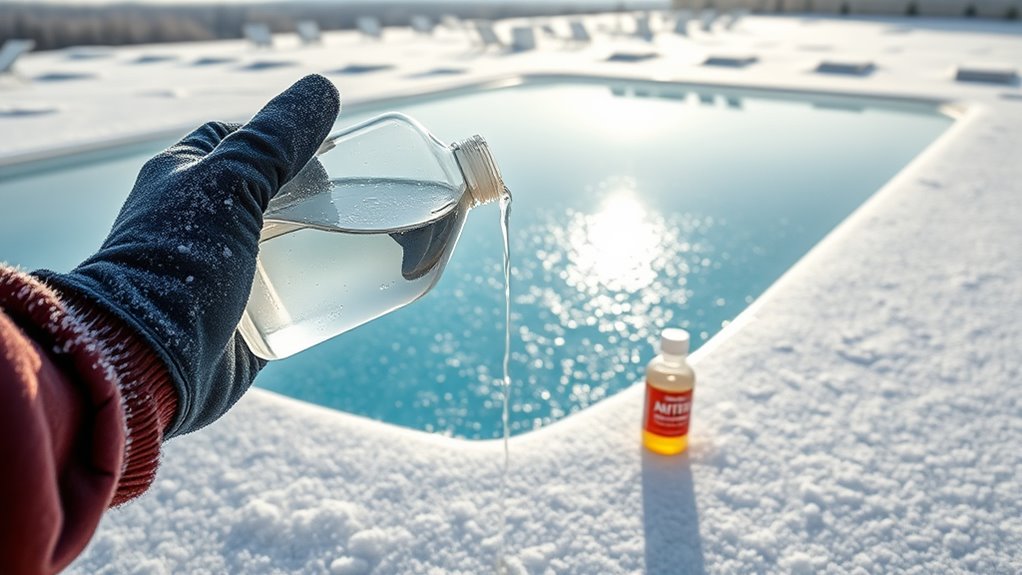
To safeguard your pool during winter, you need to choose the right chemicals that prevent algae growth and corrosion. Make sure to apply antifreeze properly to all plumbing lines to avoid freezing and damage. Correct selection and application ensure your infinity pool stays safe and in good shape through the cold months. Additionally, using security systems can help monitor your property and prevent potential damage or theft during your absence.
Selecting Appropriate Chemicals
Choosing the right chemicals is essential to protect your infinity pool during the winter months. You want to prevent algae growth, corrosion, and scale buildup. To do this effectively, focus on these four key chemicals:
- Algaecide – Keeps algae from thriving under the winter cover.
- pH Balancer – Maintains proper pH levels to prevent corrosion and scaling.
- Water Clarifier – Clears out debris and keeps water clean for easier winter maintenance.
- Antifreeze – Protects plumbing and equipment from freezing damage.
Selecting these chemicals carefully ensures proper chemical balance**** and guarantees your pool remains protected, clean, and ready for a smooth opening in spring. Always follow manufacturer instructions and test water regularly to maintain proper chemical balance.
Proper Antifreeze Application
Applying antifreeze and winterizing chemicals correctly is essential to prevent freezing and damage to your infinity pool’s plumbing and equipment. First, guarantee you use a non-toxic, pool-specific antifreeze rated for plumbing systems. Start by draining the water from your pump, filter, and pipes, then pour the antifreeze into the skimmer, main drain, and any other pipes. Use a funnel for precise application and avoid overfilling. Next, add winterizing chemicals, such as algaecides and pH stabilizers, to protect against algae and corrosion during the off-season. Follow manufacturer instructions carefully for dosage. Once all chemicals and antifreeze are in place, run the pump briefly to circulate the mixture throughout the system, ensuring every pipe and component is protected from freezing damage. Proper antifreeze application helps prevent costly repairs and ensures your pool remains in good condition for the next season.
Securing Pool Equipment and Covering the Pool
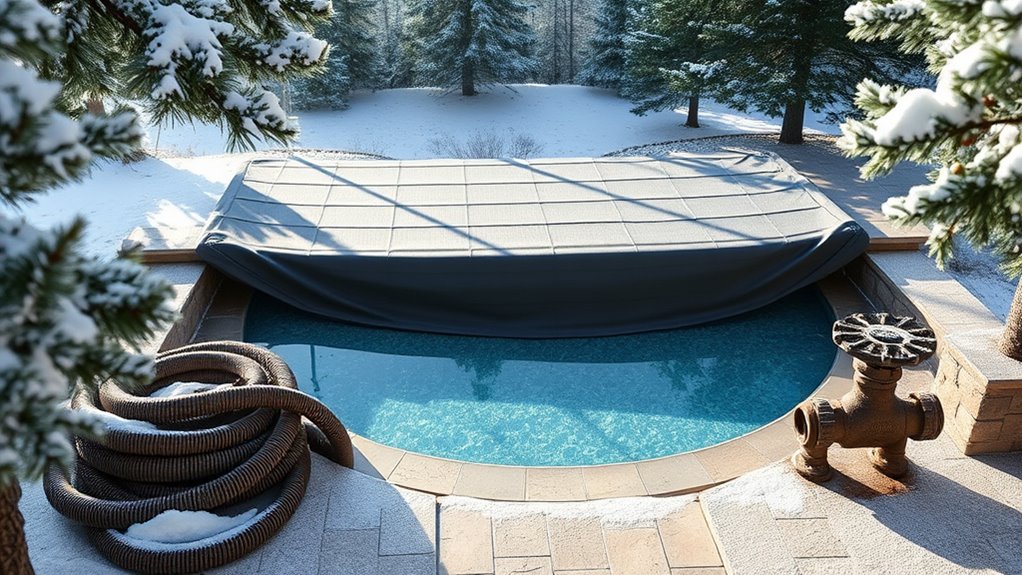
As winter approaches, securing your pool equipment and covering the pool become essential steps to protect it from harsh weather conditions. Properly safeguarding your equipment prevents damage from ice, snow, and debris. Here are four key actions to take:
- Disconnect and store all pumps, filters, and heaters in a dry, protected area.
- Secure loose items like ladders and skimmers to prevent damage or loss.
- Install a sturdy cover that fits tightly to keep out debris and prevent snow buildup.
- Use weights or anchors to hold the cover firmly in place against winter winds.
Taking these steps ensures your equipment remains safe and your pool stays clean, making spring startup easier and more efficient.
Insulating Pipes and Equipment for Extra Protection
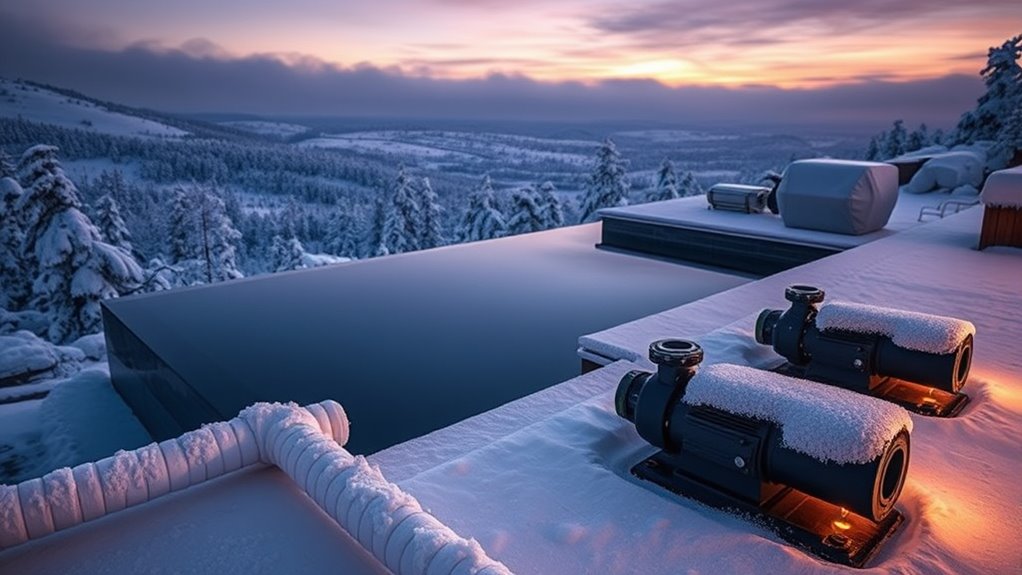
To prevent pipes and equipment from freezing and cracking during the cold months, insulating them is essential. You should wrap exposed plumbing with foam pipe insulation or use specialized insulation sleeves, guaranteeing no gaps remain. This creates a thermal barrier that retains heat and protects against freezing temperatures. For pumps, filters, and heaters, consider insulating cabinets or enclosures, especially if they’re outdoors. Applying insulation tape or blankets around these components can also help maintain ideal temperatures. Be sure to seal all joints and connections tightly to prevent cold air infiltration. Insulating your equipment reduces the risk of costly damage and ensures your pool systems operate smoothly come spring. Taking these extra steps makes winterization more effective and gives you peace of mind during harsh weather.
Regular Maintenance Checks During the Cold Season
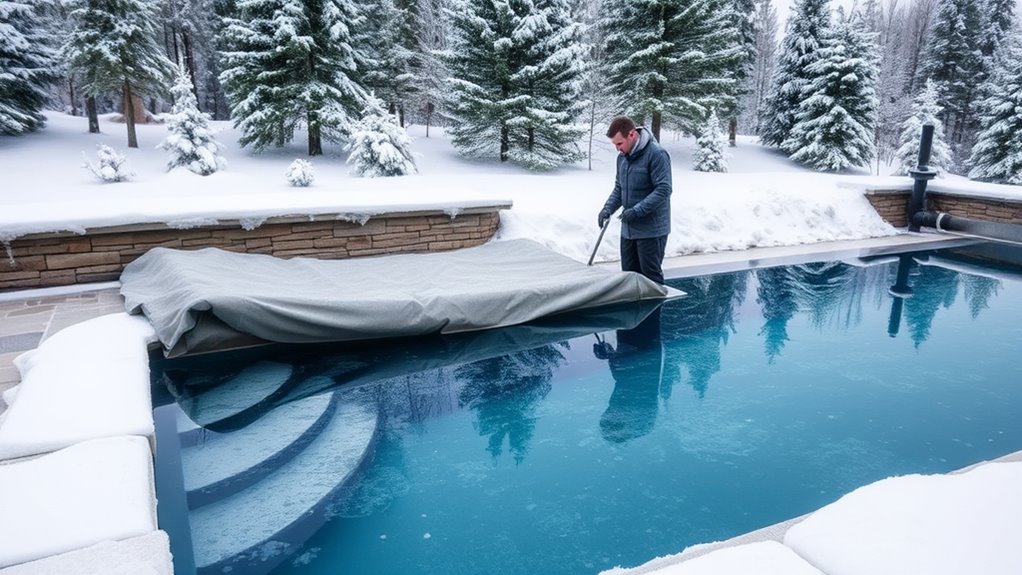
Regular maintenance checks are crucial during the cold season to catch potential issues early and prevent costly damage. You should inspect your pool regularly to guarantee everything functions smoothly. Here are four key checks to focus on:
- Visual Inspection: Look for cracks, leaks, or ice buildup around the pool and equipment.
- Pump and Filter Check: Ensure pumps are operating correctly, and filters are clean to avoid freezing.
- Water Level Monitoring: Keep the water at the recommended level to prevent equipment strain.
- Cover Integrity: Examine the pool cover for tears or debris that could cause damage or block drainage.
Consistent checks help identify problems before they escalate, saving you time and money while maintaining your pool’s longevity during winter.
Frequently Asked Questions
How Often Should I Inspect My Pool During Winter?
You should inspect your infinity pool at least once a month during winter. Check for debris, ice formation, and any potential leaks or damage. If you notice ice buildup, remove it carefully to prevent damage. Keep an eye on the water level and ensure the cover stays secure. Regular inspections help catch issues early, ensuring your pool stays protected and in good condition throughout the cold months.
Can I Leave My Pool Partially Filled During Winter?
Sure, leaving your pool partially filled is like dressing a snowman in a tank top—dangerous and unwise. You should fully winterize your infinity pool, draining it to prevent ice damage. A partially filled pool risks cracks, leaks, and costly repairs. Instead, drain the water, blow out the lines, and cover it properly. Trust me, your pool prefers hibernation over frozen chaos.
What Signs Indicate My Pool Needs Urgent Winter Repairs?
If your pool shows cracks, leaks, or your water level drops unexpectedly, it’s a sign urgent repairs are needed. You might also notice tile damage or equipment issues like malfunctioning pumps or filters. If you see algae buildup that won’t clear or cloudy water despite treatment, it indicates deeper problems. Address these issues promptly to prevent further damage, protect your investment, and ensure your pool stays in good shape for future use.
Is Professional Winterization Recommended for Infinity Pools?
Yes, professional winterization is highly recommended for infinity pools. These pools have complex plumbing and structural features that require expert care to prevent damage from freezing temperatures. Professionals ensure proper draining, chemical balancing, and insulation, reducing the risk of costly repairs. By hiring experts, you can rest assured your pool is safeguarded, and you’ll avoid potential issues like cracked tiles or damaged equipment come spring.
How Do I Prevent Ice Damage to My Pool Structure?
Like a knight guarding their fortress, you must protect your infinity pool from ice damage. You should lower the water level, add a robust pool cover, and use a high-quality pool antifreeze in the plumbing. Running the pump intermittently prevents freezing. Additionally, installing a pool heater or de-icer can keep water moving and temperature steady, preventing ice from forming and damaging your structure during winter’s coldest days.
Conclusion
By taking these careful steps, you gently guide your infinity pool through winter’s quiet embrace, ensuring it remains a serene sanctuary for future enjoyment. With patience and attention, you prevent potential issues from quietly taking root, allowing your pool to rest peacefully beneath its winter veil. When spring arrives, you’ll be rewarded with a beautifully prepared space, ready to awaken—ready to once again reflect your dedication and care.
